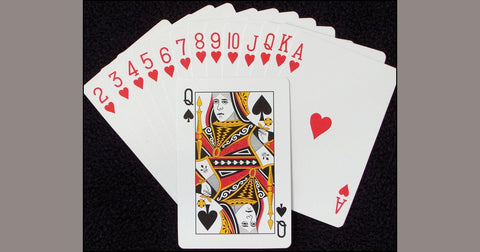
#HEARTS CARD GAME RULES HOYLE SERIES#
The series owes its name to Edmond Hoyle.
#HEARTS CARD GAME RULES HOYLE SIMULATOR#
That is an invalid play.Hoyle's Official Book of Games: Volume 1 was the first card game simulator series released by Sierra entertainment. Which foundation pile (1-4) do you want to play on? 3 Which foundation pile(1-4) do you want to play on? 4Įnter the card number for the drawn card: 29 Which foundation pile(1-4) do you want to play on? 2 Which waste pile (1-4) do you want to play from? 2 Which foundation pile (1-4) do you want to play on? 4 Which waste pile (1-4) do you want to play on? 4Įnter the card number for the drawn card: 7 Which foundation pile (1-4) do you want to play on? 1Įnter the card number for the drawn card: 12 Which waste pile (1-4) do you want to play on? 3Įnter the card number for the drawn card: 1 Which waste pile (1-4) do you want to play on? 2Įnter the card number for the drawn card: 17 Which waste pile (1-4) do you want to play on? 1Įnter the card number for the drawn card: 11 What would you like to do: (Enter -1 to quit)Įnter the card number for the drawn card: 48 Extra Credit: Use enums for the suit and face of the cards.Įnter the card number for the starting A: 13Įnter the card number for the starting 2: 27Įnter the card number for the starting 3: 28Įnter the card number for the starting 4: 42.Provide an option to the user to display their game stats. The stats should include the number of games won (meaning there were no cards left at the end of the game), the number of games lost, the average score (you will need to know the score total and the total number of games played to calculate the average. Read the stats from the file and add to them the outcome of the current game. Extra Credit: Use a file to keep track of win/loss stats.Extra Credit: Display the cards as ASCII Art.You are not allowed to use the Vector datatype for this assignment.

(Any functions written in class demos do not count toward the 3). You will also need to empty the foundation and waste piles, and ask the user for the starting 4 foundation cards again. You will need to reset the deck so that all cards are unused. After the game ends, ask the player if they want to play again.The final score is calculated based on the number of unplayed cards remaining in the waste piles and the deck.Play ends when the stock (deck) runs out of cards and there are no more valid plays from the top of the waste pile.Only the top card of each waste pile is in play.The waste piles have no restrictions on what can be played where. Any cards that cannot be played should be put into a waste pile.Users should not be allowed to play a card that doesn't fit the sequence of the foundation pile.If the user types any letters in place of the card number then the program should fix the input failure and reprompt for the information. Users should not be allowed to draw a card that has already been drawn, and they shouldn't provide a card number that is outside of the array contained in the deck. During game play the user will draw a card from the deck (by providing the card number) and try to play it on one of the four foundation piles or one of the four waste piles.INPUT VALIDATION: Make sure that the card index given corresponds to the correct starting card.

Next, ask the player for the deck position of the starting A, 2, 3, 4 for the foundation piles.INPUT VALIDATION: Make sure the user has typed either y, Y, n, or N.If the user types an N or n then the program should finish. Ask the Player if they are ready to play and only proceed if they tyype a Y or y.Options(allows extra credit to be enabled) 3. Start with displaying a menu with 3 options to the user 1.You will need to use arrays to organize the foundation piles, waste piles, and the deck of cards.If the deck indexes are out of order, you will not be able to pass the IO tests. The cards will be drawn and played by providing an index into the deck array. When creating the deck you should creaate all diamonds first, next creaate all clubs, followed by all hearts, and finally all spades.You will also need to keep track of which cards from the deck have already been played. The deck will be an array of 52 cards one of each face/suit combination. Creaate a struct to manage a deck of cards.Every card has a suit (diamonds ♦, clubs ♣, hearts ♥, spades ♠), and a face (A, 2, 3, 4, 5, 6, 7, 8, 9, 10, J (Jack or 11), Q (Queen or 12), K (King or 13))

Any card turned from the stock, and the top card of each wastepile, is available for play to the foundations.

These piles may be (and should be spread so that all cards can be read. Turn up cards from the stock one at a time, putting unplayable cards in any of four wastepiles. They are to be built up as follows, by number alone regardless of suits: Put in a foundation row any ace, duce(2), trey(3), and fourspot(4)įoundations. Game Rules from Goren's Hoyle Encyclopedia of Cards (1961)


 0 kommentar(er)
0 kommentar(er)
